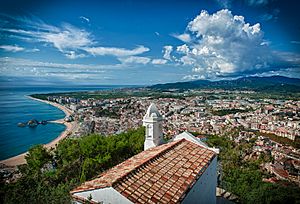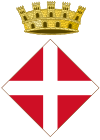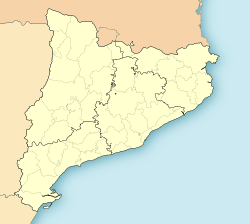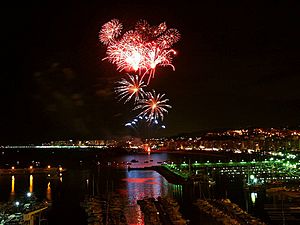Blanes facts for kids
Quick facts for kids
Blanes
|
|||
|---|---|---|---|

Overview of Blanes from the top of the mountain
|
|||
|
|||
| Country | Spain | ||
| Community | Catalonia | ||
| Province | Girona | ||
| Comarca | Selva | ||
| Area | |||
| • Total | 17.7 km2 (6.8 sq mi) | ||
| Elevation | 13 m (43 ft) | ||
| Population
(2018)
|
|||
| • Total | 38,790 | ||
| • Density | 2,192/km2 (5,676/sq mi) | ||
| Demonym(s) | Blanenc/ca | ||
| Postal code |
17300
|
||
Blanes is a lively town and municipality in Catalonia, Spain. It is located in the Girona province, within the Selva area. Blanes is often called the "Gateway to the Costa Brava" because it's where this beautiful coastline begins. The Costa Brava stretches all the way from Blanes to the border with France.
Blanes is a popular spot for tourists. It's famous for its amazing Concurs de Focs d'Artifici, which is a huge fireworks competition. This event happens during the Santa Anna festival. The town also has lovely botanical gardens, pretty coves like Cala Bona, and beaches surrounded by mountains.
Contents
History of Blanes
The story of Blanes began even before the Romans arrived. Ancient Iberian people lived here a long time ago. The Romans started to settle in Blanes and the nearby areas around 300 BC. You can still find Roman remains from a place called Blandae close by.
After the Romans, many different groups ruled the area. These included the Goths, then the Moors, and finally the Christians. In the 1200s, after the Christians took control again, many important buildings were built in Blanes. These included a palace called Palau Vescomtal, the Església Parroquial church, and the city walls.
In the 1600s, during a conflict called the Catalan Revolt, Blanes was almost completely destroyed by fire. The old Palau Vescomtal palace was totally ruined. Later, the War of the Spanish Succession also affected Blanes. After these wars, people started to rebuild the town and grow more crops.
Population of Blanes
In 2017, about 38,813 people lived in Blanes. The town has grown a lot over the years. For example, in 1900, there were less than 5,000 people living there. By 2010, the population had grown to over 40,000.
Botanical Gardens
Blanes is home to some beautiful botanical gardens. One of the most famous is the Marimurtra garden. It covers a large area, almost 15 hectares. This garden has more than 4,000 different kinds of plants! About 300,000 people visit it every year.
Another lovely garden is the Pinya de Rosa. This garden is even bigger, with over 7,000 different plant species.
Fireworks Competition
The main festival in Blanes is called Festa major, or the festival of Santa Anna and Sant Joaquim. It usually takes place in the third or fourth week of July, from July 21st to 27th, every year. During this week-long festival, there is a huge international fireworks competition. It's called the European Concurs de Focs d'Artifici. This event attracts more than 500,000 visitors! Over 500,000 kilograms of fireworks are used at each event. Most people watch the amazing show from the beach.
The first time fireworks were recorded in Blanes was in 1906. But it wasn't until 1962 that it became an annual event. The first actual fireworks competition happened in 1971, lasting three nights. The number of nights has changed over the years, sometimes even lasting seven nights. Since 1958, the fireworks have always been launched from Sa Palomera. This is a big rock that divides the two parts of the Blanes coast. It's seen as the symbolic start of the Costa Brava.
Each night of the competition, a different fireworks company shows off its display. Each show lasts between 20 and 24 minutes. A special "Popular Jury" is chosen each year to pick the winners. The fireworks competition almost always happens in the last full week of July. In 2018, it was the 48th time the competition was held. A local radio station, Radio Marina, reported that almost one million people came to see the fireworks over its five-day run.
Before 2012, the competition lasted for five days in a row. But during a financial crisis in Spain, it was shortened to four days to save money. In 2016, enough sponsors were found to bring back the fifth day of the event.
Festa Menor
The Festa menor is a smaller festival that celebrates the town's co-patrons, Sant Bonòs and Maximià. It's usually held in mid-August. A popular event during this festival is "la Nit de la Caminada Popular," which means "the night of the popular walk." This walk has been happening for over 30 years! It's a fun, family-friendly walk that many people do with their children and even their pets. The walk is about 8 kilometers long. Everyone who finishes gets a small souvenir and a slice of watermelon.
2008 Storm
On December 26, 2008, a very strong storm hit the beach in Blanes. It was on Boxing Day. The port of Blanes was hit the hardest. The old seawall couldn't stand up to the storm. Many boats were damaged or even thrown onto the beach. Before the storm, there were plans to improve the harbor, but the repairs were delayed. Because the harbor was in poor condition, it was more easily damaged by the storm. Locals often say this was the worst storm Blanes had seen since the 1950s.
Sport in Blanes
Blanes has its own football team called Club de Futbol Obispado. The city also has a roller hockey team, Blanes Hoquei Club. They play in the main league, called OK Liga. Blanes is also famous for hosting an international roller hockey tournament, the Golden Cup.
Notable People from Blanes
- Quim Torra (born 1962) – a lawyer, journalist, and former leader of Catalonia.
- Mamadou Tounkara (born 1996) – a footballer.
- Rubén Yáñez (born 1993) – a footballer.
- Roberto Bolaño – a famous writer from Chile who wrote novels, short stories, poems, and essays.
Twin Towns
Images for kids
-
Panorama of Blanes taken from Saint John's Castle. The biggest mountain (on the right) is the Montseny.
See also
 In Spanish: Blanes para niños
In Spanish: Blanes para niños








